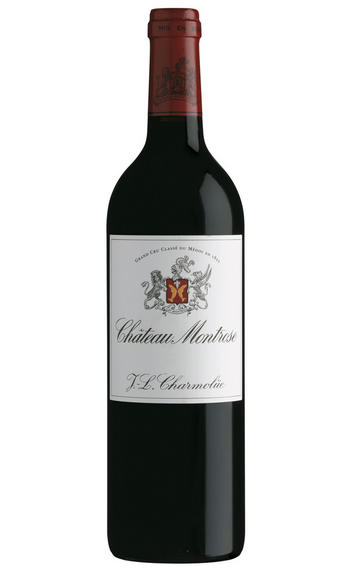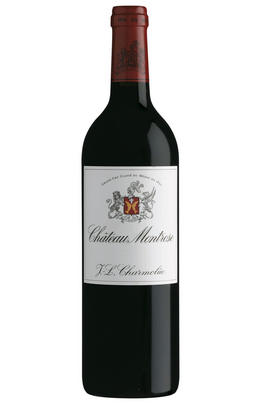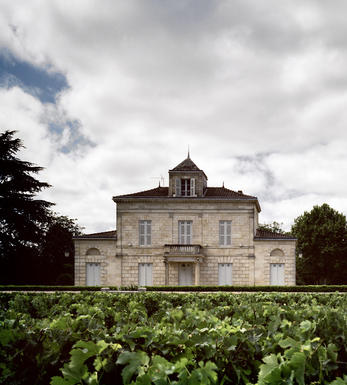
2003 Château Montrose, St Estèphe, Bordeaux

Critics reviews
Very dark crimson, the deepest of all these wines, with colour all the way out to the rim. Young, fresh, very frank aromas – still distinctly unevolved. Extremely dry, savoury and mineral – not a hint of the raisiny sweetness that dogs so many 2003s. It is wonderfully rich and layered yet dry and savoury on the finish. A hint of unsweetened chocolate with a floral top note. Great hit on the front palate, then something dry and scrunchily appetising on the finish. Very very long.
Drink 2015 - 2030
Jancis Robinson MW, JancisRobinson.com
The 2003 Montrose was served blind in Bordeaux on two occasions. Picked between 11 and 26 September, it is a blend of 62% Cabernet Sauvignon, 34% Merlot, 3% Cabernet Franc, and 1% Petit Verdot. It remains one of the outstanding wines of a very black-and-white vintage. Without knowledge of the vintage, I hesitated to suggest 2003, because though fruit intensity is locked up inside this Saint Estèphe, it is counterbalanced by the estate's trademark masculinity and austerity. So, it reaches this happy medium on the nose and the palate: pure blackberry, graphite and roasted herbs on the nose, perhaps even more elegant than I have observed on previous bottles.
The palate is medium-bodied rather than full-bodied, with sturdy tannins couched in layers of seamless blackberry and cassis fruit, offset by scents of tobacco and graphite. As usual, it has immense length and depth, a Montrose that is really just a few chapters into what is sure to be a longer "book" than many other 2003s. It is not a perfect Montrose, but a few hairs' breadth away.
Drink 2020 - 2050
Neil Martin, Wine Advocate (March 2017)
After the 2009, this is the most exciting Montrose ever made, with intense aromas and flavours of plums, blueberries, spices, tobacco and cedar. It’s full-bodied with extremely refined tannins but a dense, delicious palate.
Ready to drink now
James Suckling, JamesSuckling.com (June 2013)
The grapes were harvested between September 11 and 26. The blend in 2003 was 62% Cabernet Sauvignon, 34% Merlot (a very high percentage), 3% Cabernet Franc and 1% Petit Verdot.
Unlike most 2003s, the wine has a freshness and liveliness provided by its extraordinary terroir. It can be drunk now. It has a dense bluish/purple colour to the rim and a remarkable nose of blueberries and mulberries, with blacker cassis and blackberry entering the picture. Scorched earth, spice and liquorice are all present in this magnificent, full-bodied, opulent wine that is very Montrose, very classic and somewhat atypical of the vintage.
Anticipated maturity: 2015 - 2040
Robert M. Parker, Jr., Wine Advocate (August 2014)
A prodigious beast of a wine that's now starting to shed just a touch of its considerable baby fat, the 2003 Château Montrose is based on 62% Cabernet Sauvignon, 34% Merlot, 3% Cabernet Franc, and the rest Petit Verdot. It shows the vintage's richness with its ripe, opulent core of fruit, yet it freshens up noticeably with time in the glass, offering currants, mulberries, smoked tobacco, minty herbs, and liquorice. Full-bodied, deep, and powerful on the palate, it still has classic Bordeaux focus and structure. It's drinking brilliantly today with a decant and has another 20-30 years of prime drinking.
Drink 2022 - 2052
Jeb Dunnuck, JebDunnuck.com (August 2022)
Sur colle Ruby-red. Aromas of black cherry, liqueur-like chocolate and exotic spices. It is oversized and thick, with a texture of liquid silk and palate-saturating sweetness—a wonderfully opulent, utterly seamless wine with expressive flavours of black raspberry, smoke and camphor. Today, the wine's extraordinary charm is hiding its substantial underlying structure. It finishes with mouthcoating, utterly noble tannins. The crop level here was 33.5 hectoliters per hectare, notes Laguarigue—a monument of the vintage.
This chateau has been on a roll in the new millennium, and the 2004 is once again a vintage superstar. According to Regisseur Philippe de Laguarigue, 2004 is a surprising vintage, in which "the maturity was made in September." He explained: "During the magnificent September, warm days and cool nights eliminated any possible rot. We feared dilution due to the big crop [57 hectoliters per hectare], but although the clusters were huge, the individual grapes were of a standard size. There was much concentration of colour and tannins. The wines are supple and fat, not austere, with the tannins more elegant than those of the 2002.
Stephen Tanzer, Vinous.com (May 2005)
About this WINE

Château Montrose
Château Montrose is part of our Spotlight on sustainability series. You can view the full range here.
Château Montrose is one of the leading wine properties of St.Estéphe, and produces some of the longest-lived wines in the Médoc. Montrose had been owned by Jean-Louis Charmolue from 1962 until 2006, when it was sold to Martin and Olivier Bouygues, owner of the eponymously named construction firm Bouygues, is located in the east of the appellation, just north of the hamlet of Marbuzet, on a gravel knoll only 800 metres from the Gironde estuary. The proximity of the estuary ensures a microclimate that protects against frost, and the vines, which lie on deep clay-gravel soils, benefit from a south-easterly aspect.
Montrose's wine is typically a blend of 65% Cabernet Sauvignon, 25% Merlot and 10% Cabernet Franc and is matured in oak barriques (30% new) for 18 months.
Montrose wines are traditionally deeply coloured, austere and powerful when young, yet possess superb ageing potential, and when mature are quintessential St.Estèphe clarets. Montrose is classified as a 2ème Cru Classé.

Saint-Estèphe
Saint-Estèphe is the northernmost of the most important communes of the Médoc and borders Pauillac on its southernmost border, with only a gully and stream separates it from Ch. Lafite. To the north lies the Bas-Médoc.
Saint-Estèphe is defined by the depth of its gravel, which is ubiquitous but of varying depths and occasionally very shallow, when clay predominates. This keeps the soil cooler and wetter than its counterparts so that the wines can appear fresh in lighter vintages, but superbly successful in hot, dry years.
The best châteaux in the south of the commune have the deepest soil and the thickest gravel. Cos d'Estournel has an exceptional terroir with its vineyards being located on a south-facing ridge of gravel with excellent drainage.
Saint-Estèphe is the least gravelly of main Médoc communes and in the north of the commune the vineyards are heavier and more clay-based leading to a rustic style of wine being produced.
The wines can appear austere in youth with a discernable ferric note at some châteaux, but the best typically display good depth of colour, pronounced acidity an tannins in youth and are exceptionally long-lived. At their best, they are the equal of almost any Bordeaux. The well-regarded St Estèphe co-operative controls the production of about half the appellation.
Recommended Châteaux
Cos (Ch. Cos d'Estournel), Ch. Montrose, Ch. Calon-Ségur, Ch. Lafon-Rochet, Ch. Les Ormes de Pez, Ch. Beau-Site, Ch. Cos Labory, Ch. Phélan-Ségur

Cabernet Sauvignon Blend
Cabernet Sauvignon lends itself particularly well in blends with Merlot. This is actually the archetypal Bordeaux blend, though in different proportions in the sub-regions and sometimes topped up with Cabernet Franc, Malbec, and Petit Verdot.
In the Médoc and Graves the percentage of Cabernet Sauvignon in the blend can range from 95% (Mouton-Rothschild) to as low as 40%. It is particularly suited to the dry, warm, free- draining, gravel-rich soils and is responsible for the redolent cassis characteristics as well as the depth of colour, tannic structure and pronounced acidity of Médoc wines. However 100% Cabernet Sauvignon wines can be slightly hollow-tasting in the middle palate and Merlot with its generous, fleshy fruit flavours acts as a perfect foil by filling in this cavity.
In St-Emilion and Pomerol, the blends are Merlot dominated as Cabernet Sauvignon can struggle to ripen there - when it is included, it adds structure and body to the wine. Sassicaia is the most famous Bordeaux blend in Italy and has spawned many imitations, whereby the blend is now firmly established in the New World and particularly in California and Australia.


Buying options
Add to wishlist
Description
A prodigious beast of a wine that's now starting to shed just a touch of its considerable baby fat, the 2003 Château Montrose is based on 62% Cabernet Sauvignon, 34% Merlot, 3% Cabernet Franc, and the rest Petit Verdot. It shows the vintage's richness with its ripe, opulent core of fruit, yet it freshens up noticeably with time in the glass, offering currants, mulberries, smoked tobacco, minty herbs, and liquorice. Full-bodied, deep, and powerful on the palate, it still has classic Bordeaux focus and structure. It's drinking brilliantly today with a decant and has another 20-30 years of prime drinking.
Drink 2022 - 2052
Jeb Dunnuck, JebDunnuck.com (August 2022)
wine at a glance
Delivery and quality guarantee